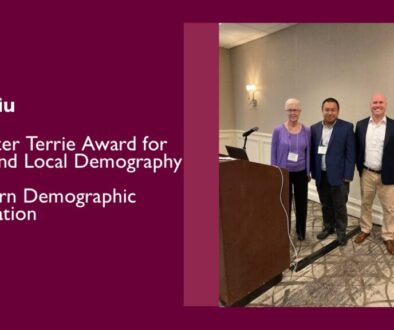Viewing Occupational Therapy and Violence through a Population Health Lens
LaShaune JohnsonLaShaune Johnson talked with with Sarbinaz Bekmuratova, Assistant Professor at the School of Pharmacy and Health Professions at Creighton University, about her work researching and teaching occupational therapy through a population health lens. Her current work looks at gender-based violence in particular.
Tell us about you, your training, and your current role.
 During my public health training at the University of Nebraska Medical Center, my research focused on the impact of macro-level structural violence on different forms of violence against women in the United States. Currently, I’m investigating violence against specific groups of women who are at heightened risk, such as women with disabilities. I am also studying human trafficking in the United States.
During my public health training at the University of Nebraska Medical Center, my research focused on the impact of macro-level structural violence on different forms of violence against women in the United States. Currently, I’m investigating violence against specific groups of women who are at heightened risk, such as women with disabilities. I am also studying human trafficking in the United States.
Although you have a population health background, you are actually working as faculty in an Occupational Therapy program at Creighton. What drew you to this position?
I teach research methods courses to doctoral occupational therapy students. I was attracted to the occupational therapy field in part because of its shared values with public health. Both occupational therapy and public health enable individuals to live their lives to the fullest by promoting health and preventing injuries, illness, and disability. Additionally, both disciplines take a holistic approach, have strong foundations in social justice, and often work with vulnerable populations. I was excited to bring my public health background and research expertise to train future occupational therapy clinicians in becoming evidence-based practitioners and advocates for their clients.
Please tell us more about your current research.
My current research focuses where public health and occupational therapy intersect and inform each other. Specifically, there is a scarcity of research on violence against people with disabilities. I’m currently investigating police officers’s perspectives about sexual violence against individuals with disabilities and the challenges these first responders may face in working with them.
I’m also exploring occupational therapy professionals’ role in assisting human trafficking survivors. Occupational therapists have a significant potential role to help this population, particularly in rehabilitation, but the current literature indicates that OTs are not part of anti-trafficking efforts. Concurrently, I’m investigating occupational therapy doctoral students’ views on human trafficking and assessing their preparedness to work with this specific population.
How does the population health lens influence how you approach teaching in OT? What lessons from public health are useful for OT practitioners?
I help my students see a bigger picture beyond the one-on-one patient care by applying the population health lens. I guide them to see the larger impact of their work; how it may benefit the client’s families, communities, and society at large, and how to inform changes at organizational levels, the built environment, and policy and research implications. I also apply a human rights and social justice perspective that encourages my students to advocate for the social needs of their patients who often experience vulnerabilities related to disability and social circumstances.
You mentioned one of your primary areas of research is violence. Can you tell our readers a little bit about violence–how it’s defined in your work, which groups are impacted, and how it has been traditionally viewed/addressed in OT?
My primary research is gender-based violence, an umbrella term that may encompass domestic violence, intimate partner violence, sexual violence, child abuse, human trafficking, reproductive coercion, psychological abuse, and economic abuse as well as invisible violence such as institutional and structural violence. Although both women and men could be affected by violence, women and girls are disproportionally more impacted by various forms of violence.
Gender-based violence is a multifaceted issue, and multiple factors put women and girls at risk for violence at different levels, including personal, interpersonal, community, societal, and large societal levels. Therefore, a multisectoral and multidisciplinary response is needed. Historically, the role of occupational therapy in domestic violence has been viewed mainly in tertiary prevention: survivor rehabilitation. However, it is vital to engage occupational therapists in domestic violence prevention and empowerment of women and girls to prevent victimization. Bringing more professionals, such as occupational therapists, to public health initiatives can advance strategies and innovative interventions for gender-based violence prevention.
Finally, do you have any advice for population health scientists interested in working across disciplines, as you are doing?
Be open to collaborating across a broad range of disciplines. Societal topics such as intimate partner violence and sex trafficking require multiple perspectives, which can be achieved only through multidisciplinary team efforts that will foster interdisciplinary dialogue and address barriers and factors at multiple levels collectively. For example, providers who do on-the-ground client work can inform policymakers and researchers by providing valuable and nuanced insight into lived experiences of people experiencing gender-based violence. Similarly, leaders can inform professionals working with victims and survivors on the political and social context and barriers at regional and national level decision-making processes.






All comments will be reviewed and posted if substantive and of general interest to IAPHS readers.